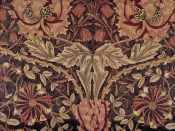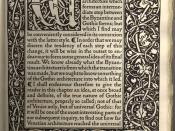Design first started before the Industrial Revolution, but my report starts here. England was the center of this revolution, which was from the 1700's- 1850's. In the pre-industrial era, villages traded with other villages, and over time villages started to specialize in producing certain products to trade. As a result, a lot of gear was being designed. Many smart people were inventing machines, but when James Watts invented the steam engine, mechanized industry developed, and industrial machines, factories, and cities took off, along with pollution, poverty, sickness and industrial accidents. The designers of these machines were rich factory owners who were skilled in mechanical design, rather than artistic design.
At this point in time a man called William Morris stepped in and started a design movement known as The Arts and Crafts Movement in 1860. Morris didn't like the way the Industrial Revolution shaped the world, because the machines were ugly and all of the products they were producing were too, so he looked to the past for inspiration.
He wanted to get rid of mass production and revive the crafts and skills of an older, pre-industrial era. He pledged himself to decorative arts, and rejected the machine. Morris was an upper class artist and poet who was well educated and fairly wealthy. He started a company called Morris and Co. He designed cloths, carpets, chairs, book covers, stained glass windows, and wall paper, which were all hand- made, and hand-painted with natural dyes. The company's designs were curved (no straight lines) and often carved by hand and therefore intricate. A lot of his work was floral, and depicted nature, as can be seen in his Tulip & Lily Carpet to the right. Tulip & Lily is one of the best-known Arts & Crafts Movement carpets, designed in 1875...


